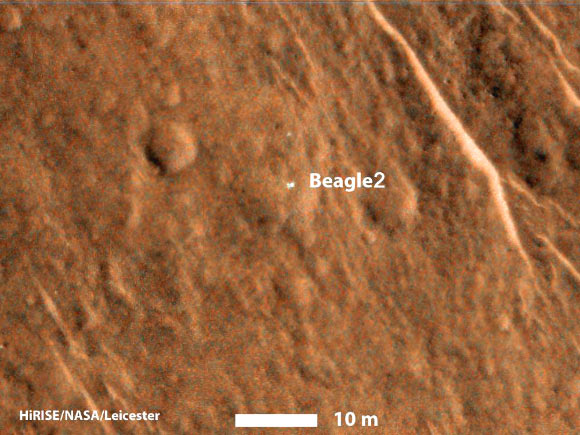The unsuccessful Beagle 2 Mars lander, thought lost on Mars since 2003, has been found partially deployed on the surface of the planet in images taken by a NASA orbiter.

This image shows a bright feature interpreted as Beagle 2 with solar arrays at least partially deployed on the surface of Mars. The location is approximately 11.5 degrees north latitude, 90.4 degrees east latitude. The image is an excerpt from HiRISE observation ESP_039308_1915, taken December 15, 2014. Image credit: NASA / JPL-Caltech / University of Arizona / University of Leicester.
Beagle-2 – the UK’s first mission to another planet – was released from its mother craft, ESA’s Mars Express, on 19 December 2003 and was due to land six days later.
But nothing was heard from the lander after its scheduled touchdown, and searches by Mars Express and NASA’s Mars Odyssey mission were fruitless.
Now, over a decade later, the lander has been identified in images taken by the High Resolution Imaging Science Experiment (HiRISE) camera on NASA’s Mars Reconnaissance Orbiter.
Beagle-2 is seen partially deployed on the surface, showing that the entry, descent and landing sequence worked and it did indeed successfully land on Mars on Christmas Day 2003.
“The history of space exploration is marked by both success and failure. This finding makes the case that Beagle 2 was more of a success than we previously knew and undoubtedly an important step in Europe’s continuing exploration of Mars,” said Dr David Parker of the UK Space Agency.
“We are very happy to learn that Beagle-2 touched down on Mars. The dedication of the various teams in studying high-resolution images in order to find the lander is inspiring,” said Dr Alvaro Giménez of the European Space Agency.
“Not knowing what happened to Beagle-2 remained a nagging worry. Understanding now that Beagle-2 made it all the way down to the surface is excellent news,” added Rudolf Schmidt, ESA’s Mars Express project manager at the time.
Prof Mark Sims of the University of Leicester, who was an integral part of the Beagle 2 project from the start leading the initial study phase, said: “I am delighted that Beagle 2 has finally been found on Mars.”
“Every Christmas Day since 2003 I have wondered what happened to Beagle 2. My Christmas day in 2003 alongside many others who worked on Beagle 2 was ruined by the disappointment of not receiving data from the surface of Mars. To be frank I had all but given up hope of ever knowing what happened to Beagle 2. The images show that we came so close to achieving the goal of science on Mars. The images vindicate the hard work put in by many people and companies both here in the UK and around Europe and the world in building Beagle 2.”
The images, following analysis by members of the Beagle 2 team and NASA, show the Beagle 2 lander in what appears to be a partially deployed configuration, with what is thought to be the rear cover with its pilot/drogue chute and main parachute close by.
Due to the small size of Beagle 2 – less than 2 meters across for the deployed lander, it is right at the limit of detection of imaging systems orbiting Mars.
The targets are within the expected landing area at a distance of about 5 km from its center.
Several interpretations of the image of the lander have been identified, consistent with the lander’s size and shape.
The imaging data is however consistent with only a partial deployment following landing.
This would explain why no signal or data was received from the lander – as full deployment of all solar panels was needed to expose the RF antenna which would transmit data and receive commands from Earth.
“I can imagine the sense of closure that the Beagle 2 team must feel,” said Richard Zurek of NASA’s Jet Propulsion Laboratory, Pasadena, project scientist now for Mars Reconnaissance Orbiter.
“Mars Reconnaissance Orbiter has helped find safe landing sites on Mars for the Curiosity and Phoenix missions and has searched for missing craft to learn what may have gone wrong. It’s an extremely difficult task, as the craft are small and the search areas are vast. It takes the best camera we have in Mars orbit and work by dedicated individuals to be successful at this.”







